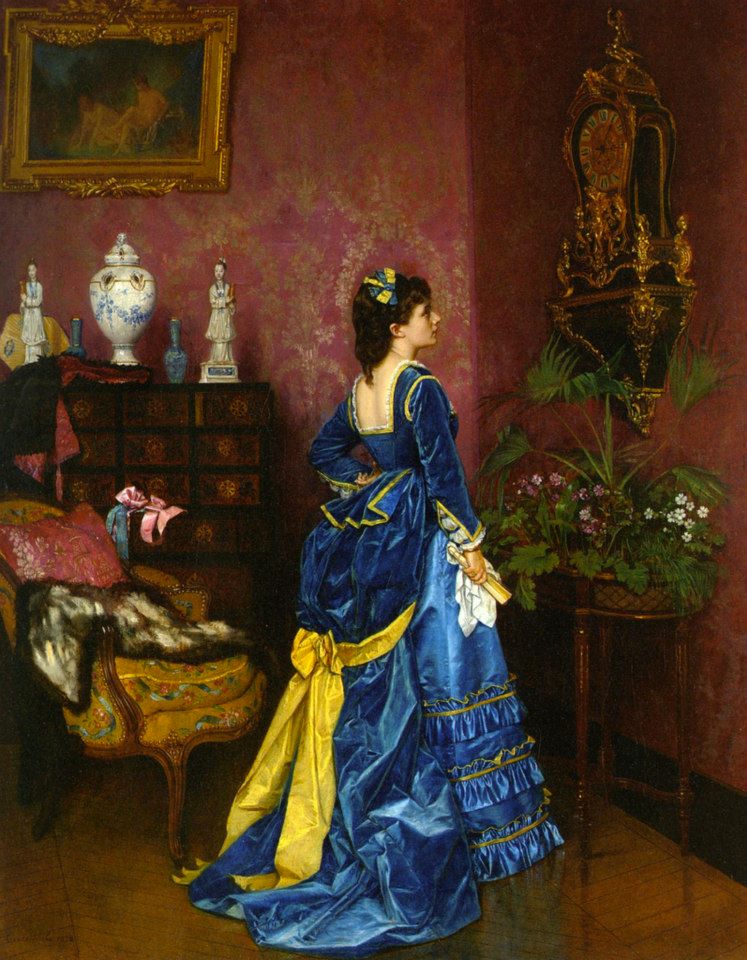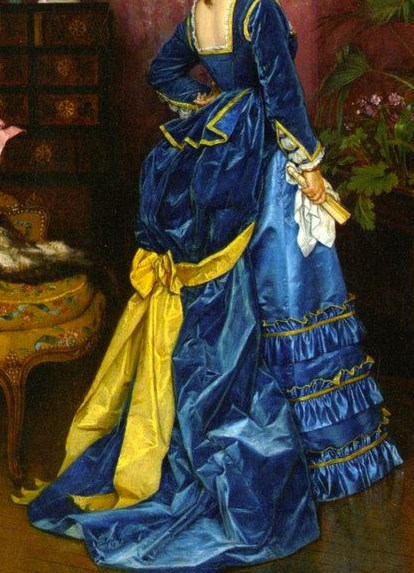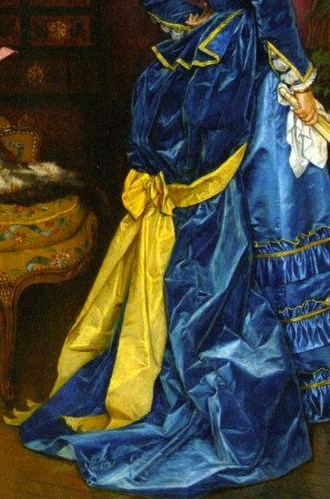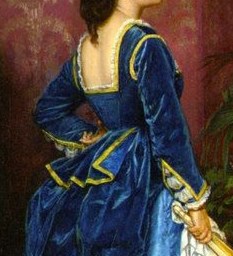
Many of us, I think, use paintings, photographs and fashion plates as inspiration for our historical costumes. I mean, why not? They are beautiful and fully represent the time period of our choice.
So what happens when we approach the creation of a particularly (seemingly) difficult garment? It’s so easy to be trapped into inaction because we simply don’t know where to start.
I posted the above photo, The Blue Dress, 1872, by Auguste Toulmouche a few months ago and wanted to share how to break it down into workable parts and also offer a few pattern suggestions, per your requests.
Really, it’s not so much the design of this dress but the fabric that was used. Silk velvet and silk satin. Dreamy…
The foundation skirt is made from satin, the train/overskirt in velvet and the bodice also in velvet. Trims include yellow ribbon or piping around the neckline, armhole, sleeve hem/opening, bodice peplum, and a yellow sash on the train. The yellow accent is continued as lining for the skirt ruffles and the cord holding them in place.
Victorian ensembles are generally built from the bottom up and the skin out. This gown is no different. You want to start your reproduction with the foundation skirt. (For those of you cocking your eyebrow at me – you’ll, of course, need to build the silhouette first with chemise & drawers, corset, and bustle.
I’d recommend a good skirt pattern to start you off right and you can’t beat the Truly Victorian TV201. It’s a basic, but fantastic, skirt pattern with the full, early 1870s silhouette you need for this dress. Make it in a silk satin if you have the funds; or in a silk taffeta for elegance. Use a high-quality poly bridal satin if you’re on a budget.
The three skirt ruffles are cut from the same fabric so add a couple extra yards for those.

Next you want to sew up the train/overskirt piece. It looks simply like a wide panel that’s been bustled up a bit right above the knee area.
You can see a seam there on the lower half; that’s most likely because of the narrow silk material that was used. Eighteen inch wide silk fabric was a common width. With our wide 54″ and 60″ wide silks today, I’d suggest either one full width or a one & a half width with seams to the sides rather than at center back.
No pattern is really necessary here. Cut a panel of fabric the length of measure from your waist down over the bustle support and for as long out as you want the train. You’ll need to allow a few inches for bustling at the back. Remember to add hem and waist seam allowances.

Take a closer look. Does the top pouf look darker than the lower train part? Yeah, it does to me too. To save money, you could use the velvet for just the top pouf part of the back and seam it with the length of silk taffeta the rest of the skirt is made from. An idea, no?
Cut the full train or upper panel from velvet and flatline the upper portion with stiff organdy or netting. Put in a hem facing at the bottom for support too. Then finish with a thin lining in a habotai (China) silk, organza, or other light, lining fabric.
The train can be made up separately and either mounted to the skirt back and finished with one waistband; or finished with its own band and simply hooked on to the skirt waistband.

The bodice is our last main piece and it is spot on the Truly Victorian TV400. See that peplum tail? Uh-huh.
Sleeves are cut just about 7/8ths length with a slit up the back seam. The slit is filled in by a puffed bit of light fabric. For richness, choose a silk or cotton tulle. A smooth batiste or even lawn or voile would work too. Cover the gathering stitches with blue velvet ribbon then tack inside the finished sleeve.
Remember to flatline the velvet bodice pieces first. A silk organza would be perfect here! Add bones to the front darts and side seams at the very least.
To complete the look, cut a long length of yellow silk taffeta for the train sash. Even though silk taffeta is fairly stiff, I’d recommend two layers here, plus an organza or organdy underlining for body and support. Don’t forget the three points at the hem of each tail!
After you are dressed, stare mercilessly at the wall clock willing it to move faster for your friends to hurry their arrival.
Do you evaluate paintings to use for costume inspiration? Does this article of a dress breakdown help you to move forward? Let me know in the comments below.

I don’t think the train is a different colour than the pouf it extends from – I think it’s just at a different angle, changing how the light hits the velvet.
It would be so much fun to make a dress from a painting and then have a picture taken from that angle while in the same pose as the painting … maybe with a modern twist, like staring mercilessly at a computer loading a new program instead of a wall clock. That said, I kind of want that clock. It’s almost as fancy as the dress!
Hi.
The bustled train in this painting is, I think, a skirt put on over the satin skirt like you would hold up a skirt to see if it might fit you before trying it on in the shop, and then finished of with the taffeta ribbon. Only done for the effect it would have in the finished painting.
Here is a differnt painting of (maybe) the velet skirt in question, from the same painter on very likely the same model.
Dans la bibliotheque
And here is a different view of the bodice with a differnt overskirt on, covering the peplum and with a satin petticoat/skirt under it like the other painting and is also on the same model – notice the lack of the yellow trim – now blue.
Lady with a parrot
Even if the overskirt is not a trick from the painter, it is, as you say, made out of one countinues longe piece of silk velvet, pieced together of 4 or more widths of fabric of the day and I think the shash is made of 2 layers of taffeta, I don’t think there is any organza between the layers as good taffeta is stiff enough in it self to make a shash like that.
I also think the peplum is cut to a semi-circle shape with an inverte box-pleat at the center back to get the smooth look at the waist, while getting the fullnes over the skirt.
My quess to the fornt of the dress is that it has a square neckline like the back and possibly stops at the waist – that would be my guess. =)
Since I do some ballet, I keep getting drawn back to Degas’ paintings of the dancers at the Paris Opera. One day, I will make myself a copy of one of those beautiful white practice dresses, with a twelve layer skirt and a long satin sash…
Although the construction of dancewear has always been a bit different from that of regular clothes, I’m thinking it’s doable with a simple, sleeveless evening dress bodice, in a dainty white cotton. The lining would have to be structured, but seriously breathable, if I plan to dance in it. I can’t decide between making it over a corset or not – dancing in a corset *sucks*, but it’s historically accurate to wear a light corset under it. Grrrrr.
The skirt would be easier; more or less a standard romantic style tutu like I’ve made too many of, only on a cotton rather than stretchy base, and of tarlatan if I can find any, or another light, stiff cotton, rather than plastic net and tulle. The distinctive pinking of the bottom hem will take forever, but it will be so worth it!
Finally, a wide, trailing satin sash completes the picture. I’m seeing one in an eye catching scarlet, and one in sophisticated black.
The outfit is complete with a black velvet ribbon around the throat, and a practical updo, to ensure that I don’t eat hair on every pirouette. 🙂
And voila, Degas!
I like Tracey Gorin’s suggestion a lot. I see dresses in Frances’ books that I would like to attempt, but bringing the patten pieces to full-size is intimidating. How to put them together doesn’t seem as difficult, but that could be because I am not familiar with the techniques and I’m glossing over the tricky parts. Here’s hoping Frances does give her permission.
I would LOVE it if you could do a similar tutorial on making dresses from the Frances Grimble books (i.e. “Fashions of the Gilded Age”.) I was poring through it for a Natural Form reception dress, and found one I really like, but was completely thrown by a) not having a picture of the front, b) little to no instructions, and c) how to you even begin to size those peices up?
I’ve gone back, and have chosen a Godey’s image which I can modify the Truly Victorian patterns to fit, but I would like to use the books in the future. Where do you even start?
Thanks for the suggestion, Tracey. If I can get Frances’ blessing I would love to create an online class for how to use her books. For plates and drawings that only show one side, try the tips in this post to help you with the decision making.
The way you explained this dress/ensemble helps me so much in the ensemble I’m currently working on. Putting the train on a separate waistband is exactly what I was thinking. Thanks so much.
Sad that this is not a portrait in a portrait, where women are standing in front of a mirror showing their front 🙁
Ooooh, this is a great ensemble, though I think I’d accent with silver rather than gold/yellow (yellow is just not my colour). Your breakdown is wonderful and so helpful! And such a bad influence as I’ve got a gorgeous 5m length of a rich-looking viscose velvet in just that shade of blue (the darker shade of the bustled part) that would be so, so perfect for this sort of thing. I’d just need to back it with organdy to get the stiffness of velvets from that time and it would be a perfect fake!
My only alternate suggestion would be to not use the TV pattern for the bodice peplum as-is. Looking closely at the painting I don’t think the peplum is gathered at the waist. It looks to me that it’s cut in a fan-shaped piece. I think it would be advisable to do it that way if at all possible and avoid any additional gathering. There’s already quite a lot of gathered velvet for the trained bustle part, and to add more on top of that and to the waist of the bodice (which no one wants to be bigger than it has to be! lol) could make it really bulky, especially if you’re trying to be really period accurate and using a crisp-backed velvet with significant body. What do you think?
I think the peplum is cut on the straight then a few knife pleat folds at the waist. It’s not gathered and you need to bring in the width somehow to fit the back waist. Not many pleats though because, as you say and I agree, that pleating velvet makes it really thick! But their velvet is different than our rayon blends of today. Silk velvet would be the best choice as you could still underline with silk organza, add a thin China silk and pleat up without too much added bulk.
That is such a pretty dress! I’ve never taken a picture and fashion plate and turned into a real life dress… But I’d love to someday!